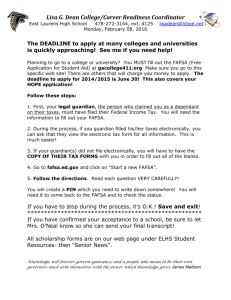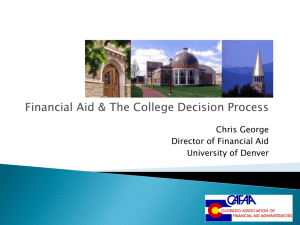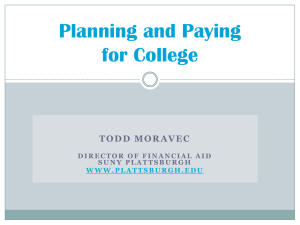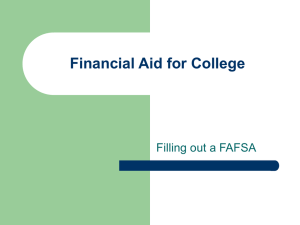View the Powerpoint from December 2013
advertisement
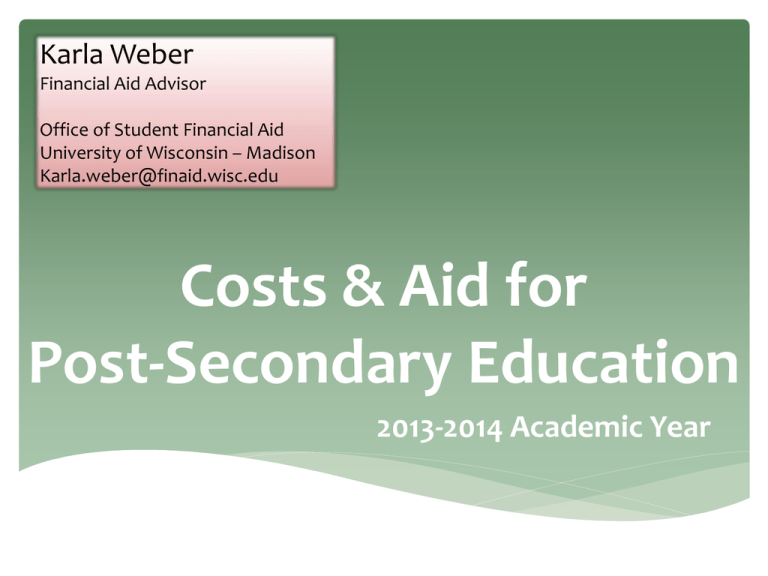
Karla Weber Financial Aid Advisor Office of Student Financial Aid University of Wisconsin – Madison Karla.weber@finaid.wisc.edu Costs & Aid for Post-Secondary Education 2013-2014 Academic Year Tonight’s Discussion Financial Aid Basics Types of Financial Aid Available The FAFSA and Application Process Questions Need Analysis Cost of Attendance Expected Family Contribution Financial Need Financial Aid Basics Goals of Financial Aid To provide greater access and opportunity for higher education To assist a student in paying for higher education To help narrow the gap between what the family can pay for and the cost of education Overview of Aid Process – Dept of Ed Video Resource Links Overview of the Financial Aid Process http://youtu.be/kbJ55UWMEFE FAFSA: Apply for Aid http://youtu.be/c-23SMf5DyQ How to Fill Out the FAFSA http://youtu.be/VRyXfUStHO0 Types of Aid http://youtu.be/Pn4OECMTh5w Repayment: What to Expect http://youtu.be/oJHySMdXjxE Financial Aid Regulations * Determined by federal and state statues and legislation * Establish an applicant’s eligibility for most types of aid * Each aid program has it’s own unique eligibility requirements * Are applicable to ALL schools that receive funding Principles of Need Analysis * To the extent that they are able, parents have the primary responsibility to pay for their dependent children’s education. * Students also have a responsibility to contribute * Evaluated in their current financial situation * Ability to pay must be evaluated in an equitable and consistent manner * Recognize that special circumstances can have major financial implications. What are the costs? + + + + Tuition and Fees Room and Board Transportation Books and Supplies Miscellaneous Living Expenses = Cost of Attendance (COA) 2012/13 Estimated Costs of Attendance (approx) Campus Living @ Home On/Off Campus UW-Madison $16,395 $23,825 UW-Milwaukee $18,512 $25,712 Madison College $5,346 $12,526 UW Colleges $13,630 $18,590 Edgewood College Marquette University $32,216 $43,804 $46,424 Expected Family Contribution (EFC) Determined by filing the FREE Application for Federal Student Aid (FAFSA) www.fafsa.gov (NOT .com!) Amount a family can reasonably be expected to contribute, but not what the family will actually pay to school An index used to calculate eligibility for aid Is NOT an estimate of “extra” cash available Stays the same regardless of college/university Assets Elements of Federal Methodology A complicated equation established by FAFSA Congress Uses both parent AND student information (for dependant students) Has standard income and asset protection allowances Ranges from 0 to 99,999 Expected Family Contribution (EFC) Financial Need Determination Cost of Attendance (COA) - Expected Family Contribution (EFC) = Financial Need Need Varies by School Cost School #1 School #2 School #3 Cost of Attendance $37,390 $18,326 $14,054 Less EFC $6,355 $6,355 $6,355 Need $31,035 $11,971 $7,699 Institutional Methodology Used by come colleges/universities to award their own institutional funds Formula can vary widely from school to school Often requires additional application/forms May consider income & assets not reported on the FAFSA such as: Home Equity Retirement Accounts Assets in siblings names Income of non-custodial parent CSS/PROFILE * Used by SOME private schools * The school should notify the student if required * Don’t trust the website’s list of participating schools (Ex. Edgewood) * Collects data beyond what’s required on FAFSA * Targets non-federal funds * Supports early estimates/admission * Application fee is $25, plus $16 for each additional school it needs to be sent to * Can complete NOW – became available October 1st Eligibility for Aid EFC Range Amount of Financial Need Adjusted Gross Income Other criteria – can vary widely Sources Grants Work Study Loans Scholarships Types of Financial Aid Three Primary Sources * US Department of Education * The federal agency that provides funding in the form of grants, work study, and loans. * State * Administer state scholarships and grants, college savings and prepaid tuition programs. * Higher Educational Aids Board (HEAB) manages aid for Wisconsin * Colleges & Universities * May offer their own scholarships, grant, and loan programs with each setting its own requirements * Availability varies WIDELY between schools Federal Pell Grant & SEOG * Pell * Awarded to the neediest Undergrad students * Based on EFC range; this current year 0 – 4,995 (Down from 5,273) * Award amount varies based on EFC and enrollment status * Maximum award for 2012/13 - $5,550 * Supplemental Educational Opportunity Grant * Must be eligible for Pell Grant * Targeted to students with highest need * Award amount as well as EFC range varies depending on college/university State of WI Funding - HEAB * Wisconsin Higher Education Grant (WHEG) * UW System, Technical and Tribal Colleges * Wisconsin Tuition Grant (WTG) * Independent Colleges & Universities (does NOT include for-profit institutions) * Academic Excellence Scholarship * Questions/Issues? Nancy.wilkison@wisconsin.gov * WI Covenant * Questions/Issues? Garth.beyer@wisconsin.gov * Minnesota-Wisconsin Reciprocity – MUST apply * http://heab.state.wi.gov/reciprocity Other various program – most require add’l application – see website * http://heab.state.wi.us Wisconsin Covenant * Senior Checklist * A confirmation form signed by: * Student * Parent * Primary Contact (School Counselor/Principal) * A record of service form * Two letters of recommendation, if necessary due to a suspension * Make copies! Certify mail! * Min award - $250, Max award - $2,500 for full-time enrollment * Important Dates * December 1st – Confirmation forms will be made available online and mailed to seniors * January 1st – Confirmation process begins * April 1st – Confirmation/FAFSA deadline! Employment * Federal Work Study (FWS) * Must show a specified amount of need * Part-time employment may be on or off campus (public/private nonprofit) * Receive funds through a regular paycheck * Earnings do not count towards future aid eligibility * Institutional Work Programs * Off campus/summer employment Loans Perkins Loan Priority to students who show “exceptional need” as defined by the school and the amount received varies Subsidized – Gov’t. covers interest as long as student is at least ½ time. Fixed Interest Rate: 5% 9 month grace period/10 year standard repayment period Institutional Loans Vary in availability and eligibility depending on college/university Federal Direct Loans Regardless of income, EVERY student qualifies if they meet the basic eligibility requirements! * William D Ford Federal Direct Loan Program (DL) * Subsidized: MUST demonstrate financial need * Unsubsidized: Not based on need (EVERY student is eligible – no matter what!!) * Annual Loan Limits * Freshmen - $5,500 total ($3,500 max subsidized) * Sophomore - $6,500 total ($4,500 max subsidized) * Junior/Seniors - $7,500 ($5,500 max subsidized) * Grad Student - $20,500 (as of 12/13 no longer have any sub eligibility) Federal Direct Loans - Benefits * No credit score or co-signer requirements * Lower/Fixed interest rate * 2012/13 - 3.4% Subsidized, 6.8% Unsubsidized * 2013/14 – 6.8% for BOTH Subsidized and Unsubsidized, BUT… * Origination Fee: 1% * In-School Deferment: student must maintain at least ½ time enrollment * 6 month grace period * Repayment period between 10 & 30 years depending on repayment plan Parent Loan for Undergrad Students (PLUS) * Program for parents of dependent undergrads as well as grads and professional students (GradPLUS) * Must pass a basic credit check * Annual Loan Limit: COA minus other accepted aid * Fixed interest rate: 7.9% * Origination Fee: 4% * 60 day grace period – “opt-in” to in-school deferment * Compare to Private/Alternative Loans PLUS Denials Additional unsubsidized loan eligibility for undergrads whose parent was denied PLUS: $4,000 per year for 1st and 2nd year students $5,000 per year for 3rd and 4th year students Borrowing Tips * Think about your ability to make the monthly payments when you leave school * Loan repayment calculators are available online * Choose any participating lender – shop around! * Compare the differences: Fixed/Variable, co-signer requirements, min/max amounts, deferment and/or forbearance options, fees, repayment period, etc * Borrow only what you need for direct educational expenses and avoid borrowing for discretionary spending * ALWAYS check with the Financial Aid Office BEFORE pursuing to make sure all other options have been exhausted Scholarships * Colleges/Universities * Need-based & non-need based: Academic, athletic, music, or other talent * Alumni Organizations * Civic Organizations * Churches, PTA, Elks, Kiwanis, cultural leagues, etc * Private businesses * Wal-mart, Best Buy, Dell, Gates Foundation, etc * Parents’ and/or students’ employers or labor unions Scholarship Searches * FREE internet search engines * Department of Labor, Employment, and Training * www.careerinfonet.org/scholarshipsearch * College Board: * www.bigfuture.collegeboard.org/scholarship-search * FastWeb: * www.fastweb.com * High School Counselors * Local library resources Other Resources * Other Government Related * AmeriCorps www.americorps.gov * Veteran’s benefits and tuition waivers * ROTC scholarships and/or stipends * Bureau of Indian Affairs Grants * Dept of Vocational Rehab (DVR) * School payment plans – may or may not be available * Home equity loans (longer repayment, tax deductible) * Life insurance policy loans * Retirement Plan loans * 529 Education Savings Plans (EdVest) www.edvest.com FAFSA IRS Data Retrieval Frequent Errors Common Questions/Confusion Special Circumstances Comparing Offers The Application Process www.fafsa.GOV Application Process * Apply for a PIN – student and one parent * www.pin.ed.gov – can request at any point either prior to or during FAFSA * Submit: * the FREE Application for Federal Student Aid (FAFSA) prior to your school’s deadline * www.fafsa.GOV (not .com!!!!) * Becomes available January 1st for the upcoming academic year * Must reapply EVERY year!!! * Any requested/required documents for verification to the school(s) * Any institutional application materials (if required/requested by your school) * Finalize school admissions * Make sure to meet ALL required deadlines! What is the PIN? * www.pin.ed.gov Personal Identification Number * Is used to electronically sign the FAFSA, but can also be used to: * Make corrections to a completed FAFSA * Sign-in to the National Student Loan Data System * Sign promissory notes for student/parent loans (Perkins, Federal Direct, PLUS) * The student and at least one parent (if dependent) must get their own * The PIN should NEVER be shared. PIN Main Page FAFSA.Gov – Student Sign-In FAFSA Steps Student Demographics School Selection Dependency Status Parent Demographics Financial Information Sign & Submit! Confirmation IRS Data Retrieval Tool * A way to simplify and reduce the number of errors on the FAFSA * Request and retrieve income and tax data directly from the IRS * VOLUNTARY! * “Should” be available beginning February 3rd * Can be used: * After at least 2 weeks of electronic tax filing * After at least 6 weeks of paper tax filing * For 2013/14 – if tool not used or changes made, may request “Tax Return Transcript” IRS Data Retrieval Tool 3 Possible Responses • You are not eligible to transfer information • Too soon since taxes filed – may not be available • Recommend to try! Citizenship Explained Only the student is required to be a U.S. citizen, permanent resident, or eligible non-citizen to receive aid Undocumented students are currently ineligible for federal and state aid Students with Deferred Action Status are also not eligible for financial aid Parents Explained * Who is considered a parent? * Two biological parents that are married to each other * Both parents information will be included on the FAFSA * Divorced/Separated parents * Will use information for whichever parent is determined to be the custodial parent * Step-parents * Widowed parent * Legal adoptive parents * This DOES NOT include legal guardians, even those that are relatives. Divorced/Separated Explained * FAFSA needs to be completed using the parent with whom the student lived with more in the past 12 months * Believe it’s equal (365 days in a year)? Use the parent who provided more financial support during the last 12 months or during the most recent year the student actually received support * If this parent has remarried, the step-parent information MUST be included on the FAFSA * Step-parent income and assets represent significant info about the family’s financial resources and help to form an accurate picture of the family’s financial strength. Assets Explained * Questions asked: * As of today, what is your total current balance of cash, saving, and checking accounts? Don’t include financial aid. * As of today, what is the net worth of your investments, including real estate? Don’t include the home you live in. * As of today, what is the net worth of your current business and/or investment farms? Don’t include a family farm or business with 100 or fewer full-time employees. * Net worth means current value minus debt. Assets Explained * Investment INCLUDE: * Real estate (but not the home you live in), trust funds, UGMA/UTMA accounts, money markets, mutual funds, stocks, bonds, other securities, installment and land sale contracts, etc * Qualified educational benefits or education savings accounts – 529 Plans * Investments DO NOT INCLUDE: * The home you live in, the value of life insurance, retirement plans (401k’s), pension funds, annuities, non-education IRAs, Keogh plans, etc. * Business and/or investment farm assets are excluded IF: * Related family members own 51% or more of the business AND * It has less than 100 full-time or equivalent employees College Goal Wisconsin! * A statewide event (31 sites) that offers FREE help to families completing the FAFSA * 8 scholarships available to those in attendance * 95.7% of families that have attended felt it was worth it! * In and around Madison * Saturday, February 23rd * Edgewood College, 1000 Edgewood College Ave * Sunday, February 24th * DeForest High School, 815 Jefferson St, DeForest * Madison College (MATC), 3550 Anderson St www.collegegoalwi.org After your file the FAFSA… * Results are sent electronically: * To the selected school(s) * To the student/parent – Student Aid Report (SAR) * If corrections are necessary, log back in and proceed as instructed * If FAFSA rejects, student/parent must correct before information will be released * Student may be required to verify their FAFSA data and will need to submit tax forms * School(s) will request documentation * Once student has been admitted, a financial aid package will be prepared * Contact the school with any special circumstances Tax Return Transcript If parent/student did not use the IRS Data Retrieval or information retrieved was subsequently changed Some schools may still choose to request even if Data Retrieval used Have to request from the IRS Online www.irs.gov By phone 1-800-908-9946 Complete and submit 4056-T Taxes filed electronically will take about 3 – 4 weeks before available, paper taxes take about 6 – 8 weeks It is a FREE document and is usually received in about 7 – 10 day from request Can no longer accept copies of the 1040. Special Circumstances Cannot report on FAFSA initially Limited to special and unique family circumstances that must be documented Usually adjustments to income due to job loss, high medical/dental expenses, recent divorce, one-time income, etc. Case by case basis School specific – not transferable CANNOT consider everything! Net Price Calculators Federally mandated Based on income information and, sometimes, academic information Will provide at least the following information: Estimated total price of attendance Estimated tuition and fees Estimated room and board Estimated books and supplies Estimate other expenses (including personal expenses and transportation) Total estimate merit- and need-based grant aid Estimated net price (cost of attendance minus grant aid) The Award Letter Vary from school to school Moving towards some amount of standardization Costs Free $$ Net Cost “The Shopping Sheet” How to Compare Aid Offers * Start with tuition, fees, room, and board * Subtract grant and scholarship offers ONLY * The difference is your “net cost” * Always compare the net cost of each school * Do not subtract work study as a lump sum – students are paid based on number of hours worked * Do not subtract loans – you’ll eventually be responsible for paying for those Proceed with Caution! * NEVER pay a fee to file the FAFSA * Make sure you’re going directly to www.fafsa.gov (NOT .com!!!!) * No need to hire someone, contact financial aid office if you need assistance * College Goal Wisconsin! * NEVER pay to apply for scholarships * Lots of FREE scholarship searches * Contact your nearest financial aid office if you have questions regarding the legitimacy of any questionable offer www.studentaid.ed.gov New Website! http://nces.ed.gov/collegenavigator College Navigator Financial Aid Myths * Enough financial aid will be offered to cover a family’s full need. * All school’s automatically offer “full-ride” merit-based scholarships to the top achieving applicants * There is an unending supply of aid – so even if we apply late, there’ll still be funds available * Our family’s income is too high to be eligible for any aid * Student loans are not financial aid So what now?! Save! Involve your student!!! Research costs at different schools Make a schedule/timeline Look for scholarships Be realistic Pay attention And…ASK QUESTIONS!!!! Questions???


